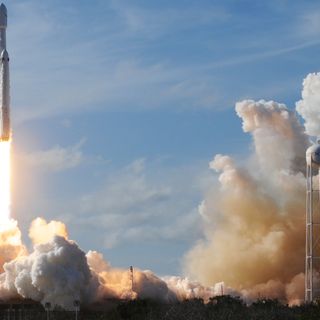"The Debate Papers" provides a platform for learned voices to argue issues affecting the United States and Australia. These counterpoints traverse topics such as economics, foreign policy and politics. If you’d like to contribute to the series, email brendan.thomas-noone@sydney.edu.au or jared.mondschein@sydney.edu.au.
The US Space Force is a good idea
Malcolm Davis
As they say in The Hitchhiker's Guide, "Space is big, really, really big". A big operational domain like space — literally infinite according to current understanding of cosmology — demands a big, bold approach to how the US military will operate in that domain. The idea of a US Space Force — an independent military force purely designed for undertaking operations in the space domain — is by very definition a ‘big idea’. It’s received a lot of criticism for a number of reasons, but dismissing the notion of a US Space Force also misses the opportunity to consider the idea’s benefits, and examine why it is a good idea.
Space wars are real
Criticism of a US Space Force as an aggressive act by the Trump administration that will kick off an arms race in space ignores the emerging astropolitical reality of the 21st century. Far from being a peaceful global commons that sits above terrestrial big power geopolitical rivalry, space is no sanctuary from warfare. Like other global commons such as the sea, air and cyberspace domains, space is highly contested. It’s a warfighting domain in its own right. Space has been militarised since the 1960s and now, with China and Russia developing counter-space capabilities (also known as ‘anti-satellite weapons’ or ‘ASATs’), space is quickly heading towards being ‘weaponised’.
For example, China is now operationally deploying anti-satellite weapons (ASATs) that could hold at risk US and allied ISR satellites, and are developing more sophisticated capabilities that could potentially target GPS and communications satellites.1 The Chinese are also experimenting ‘soft kill’ using jamming,2 high-powered microwave and lasers at close range. There is growing concern about the development of cyber-attack on satellites, either from Earth3 or via a co-orbital ASAT.
So when it comes to space war, the horse has long since bolted. The United States has to act to protect its vital capabilities. It’s a reality the United States has an obligation to deal with. It’s not an aggressive response, but a defensive response. The United States is now trying to develop the means to deter the use of counter-space capabilities, and a Space Force is part of that solution.
One of many space forces in the world
Space for growth: Prospects for Australia-US civil space cooperation

The United States is not alone in developing a space force-like organisation. In a recent RAND report, analysis on the nature of China’s PLA Strategic Support Force (PLASSF), established in December 2015, suggests that it is likely to be the basis for a potential Chinese space force in coming years. It notes that:
“…as space and cyber warfare become more developed and have a greater potential to become independent campaigns, the [PLASSF]… could become a full-fledged service.”4
Russia too has established its own space forces as part of the aerospace defence forces of the Russian military.5 Stood up in August 2015, the Russian space force perform similar functions to the US Space Command. Far from being an aggressive push to dominate space, the US Space Force can be seen to be a response to growing Chinese and Russian military space capabilities.
The United States has been consistently cautious in terms of development and deployment of space weapons since the days of the Rumsfeld Commission report in 2001.6 Both the G.W. Bush and Obama administrations' practiced restraint on ASATs. Obama’s space policy of 2010 saw the United States hold off on deploying ASATs and instead strengthen norms against ASAT development and deployment.7 The United States sought to:
"…develop capabilities, plans, and options to deter, defend against, and if necessary, defeat efforts to interfere with or attack US or allied space systems, [and] maintain the capabilities to execute the space support, force enhancement, space control and force application missions…"(p.9)
Yet this did not see the United States deploy ASATs. Instead there was a focus on building space resilience, and denying anonymity to potential adversaries threatening US and allied space systems by exploiting space surveillance architecture. The goal was space deterrence, rather than space war.
This is a policy continuation
The Trump space policy does not waver from Obama’s decision against operationally deploying ASATs, and there is no indication that a US Space Force would necessarily change that policy. Some experts suggest that far from being an aggressive shift towards US space dominance, a US Space Force may simply be a re-structure of the currently distributed elements of US military space into a single command. Space Force will simply carry on with existing space missions currently performed by the United States Air Force (USAF),8 including "monitoring satellites, preventing spacecraft from colliding with debris and other functions that the Air Force has performed quietly for decades".
Critics also attack the US Space Force, erroneously claiming that it somehow violates the 1967 Outer Space Treaty (OST)9. This criticism has no basis in fact and betrays an ignorance of what the Outer Space Treaty actually says. As I’ve made clear elsewhere,10 the idea of a US Space Force — even if the United States does choose to develop its own ASATs as a response to peer adversary capabilities — doesn’t violate the OST, which only bans deployment of WMDs in space, and the use of the "Moon and other celestial bodies for military purposes". The OST is dated, and doesn’t address new developments such as commercial space, and has loopholes which can be exploited by an opponent to evade its key articles. But the US Space Force itself is not a violation of the OST, or indeed any other space law document.
Some experts suggest that far from being an aggressive shift towards US space dominance, a US Space Force may simply be a re-structure of the currently distributed elements of US military space into a single command.
There have been some legitimate concerns about how a US Space Force would be established, what its organisational structure would be, and how it will be funded. The USAF currently leads on the space mission, and so establishing a US Space Force as separate from USAF — in much the same way the USAF was established by splitting off from the US Army in 1947 — would see the Air Force lose an important mission, along with personnel and funding. That is understandably difficult for USAF to accept. Yet, both USAF Secretary Heather Wilson11 and Secretary of Defense James Mattis12 now openly support the idea of a US Space Force, with Wilson now laying out a practical plan towards establishing such a force and concepts for what it would do.
The argument that Space Force would create unnecessary bureaucracy or duplicate functions is no longer convincing. There is a clear pathway13 going forward14 to Congress as part of the US National Defense Authorization Act FY2020 debate. Congressional approval would then allow the establishment of a Department of the Space Force that, in effect, stands up a US Space Force and meet’s President Trump’s directive with personnel and programs from USAF transferred to a ‘USSF’ in FY2021.
The USSF missions and tasks would15 see it "organize, train and equip and provide space forces for military operations, and develop tactics and doctrine for offensive and defensive space operations, including missile defense, and be responsible to gain and maintain space superiority". Under current planning, the USSF will have about 13,000 personnel, and require an additional budget of US$3.3bn for the first year of operation, and US$13bn over five years. The complaint that the US Space Force idea is vague and ill-defined can no longer be sustained.
Preparing for battle in the final frontier
At a conceptual level, the establishment of an independent US Space Force would enable DoD to think boldly about the military space mission for the 2020s and beyond. Given the fast pace of space technology developments under Space 2.0, particularly within the commercial space sector, this is absolutely vital.
It would better equip the US to ensure space superiority and control of space. In the same way that control of the air is vital, space is fast becoming a vital centre of gravity. Ensuring access to space is critical to a western way of war that emphasises speed, precision, and discrimination to minimise risk of friendly and collateral casualties. To paraphrase Field Marshall Bernard Montgomery of El Alamein’s famous axiom on control of the air, ‘to lose access to space means we lose the war and we lose it quickly’.16
Establishment of an independent US Space Force would enable Defense to think boldly about the military space mission for the 2020s and beyond. Given the fast pace of space technology developments under Space 2.0, this is absolutely vital.
Establishment of a US Space Force would give the US the opportunity to develop a force structure and military capability for the 21st century to protect that vital centre of gravity in the same way that an independent USAF in 194717 could begin to develop air power to deter the threat posed by the Soviet Union. Trying something new to grapple with a global challenge is not a bad thing.
Unfortunately, the willingness to think outside the box in solving big issues — in this case, for a US Space Force — has also been marred by criticism18 of the US Space Force idea simply because President Trump is a strong proponent. There is also a giggle factor driven by asinine discussions about logos and uniforms and ill-thought out references to pop-culture. That approach does a disservice to an important debate on a key issue of 21st century security.
The debate needs to be propelled to a higher intellectual orbit.
US Space Force: Not ready to launch
Madelyn Creedon
From the earliest days the United States has never properly organised itself to effectively manage the national security elements of space. Is a new US military department — the Space Force — the answer? Not yet.
Before getting to the current debate, it’s important to understand how the US military has historically been involved in outer space.
The birth of a US bureaucracy in space
On October 4, 1957, when the USSR launched Sputnik 1, the first man-made satellite, it was viewed as a demonstration of the USSR’s scientific and engineering prowess and superiority. Although the United States had also been working on satellites, including the Navy’s Vanguard project, the US government was surprised by Sputnik’s launch and the US public was terrified.

After the second Sputnik launch the following month, Senator Lyndon Johnson, the majority leader of the US Senate at the time, knew Congress had to respond and directed the Senate Armed Services Committee (SASC) to hold hearings “to review the whole spectrum of American defense and space programs in the wake of the Sputnik crisis”. Things got worse when, shortly after the hearings started, the first Vanguard launch was a spectacular failure. The SASC ultimately found a “serious underfunding and incomprehensible organization for the conduct of space activities”.
Even before Sputnik, the value of the high-ground of space was apparent to the intelligence community. Three years prior, President Eisenhower chartered a study that set in motion the plans to establish the National Reconnaissance Program (NRP) as a single program “to develop and operate all national reconnaissance programs either aircraft or space-based”.18 In 1961, President Kennedy stood up the National Reconnaissance Office (NRO) to manage the NRP. The new NRO, an agency in the Defense Department jointly managed by the Pentagon and the Central Intelligence Agency (CIA), took over the reconnaissance programs of the CIA, Navy and Air Force.
Formally fragmenting the bureaucracy did not help the incomprehensible organisational problem of managing national security activities in space.
The bureaucracy evolves
Even though it lost its space reconnaissance programs, the Air Force wasn’t ready to let go of the space domain and created its own program. It shifted its focus to missile development, space surveillance (using an extensive network of ground-based radars and telescopes) and space launch.19 The Air Force also returned to satellites, becoming responsible for the bulk of the military space systems including infra-red missile launch early warning satellites, a wide variety of communications satellites including those integral to the US nuclear command and control system, precision navigation and timing through the Global Positioning Systems (GPS) satellites, as well as defence weather satellites.
Space gradually became a more important and larger part of the Air Force and in 198220 it established a new major command organisation that reported directly to Air Force Headquarters: the Air Force Space Command. A new US ‘unified combatant command’ for space quickly followed in 1985, which had responsibility for all Air Force, Army and Navy space capabilities.21 The new US Space Command was headed by an Air Force 4-star general who was also dual hatted as the Commander of Air Force Space Command. Importantly, it had no jurisdiction over the NRO and its primarily intelligence gathering space capabilities.
Notwithstanding this new structure, Congress again became frustrated with the commitment to space and the conduct of space activities. As a result, a Space Commission was created in the FY2000 National Defense Authorization Act (NDAA)22 to look at space acquisition,23 and the organisational structure and management of national security space generally.
History repeats itself
Like SASC nearly half a century earlier, the commission concluded that “the US Government — in particular, the Department of Defense and the Intelligence Community — is not yet arranged or focused to meet the national security space needs of the 21st century”.
The Space Commission, wanting more integration between the intelligence community and military space activities, found that a “single official” should be appointed with the authority for the acquisition of space systems for both the Air Force and National Reconnaissance Office.
The commission was also concerned about the Air Force’s commitment to the military aspects of space, finding that there is “a need for space systems that can be employed in independent operations or in support of air, land and sea forces” and determined that a space corps within the Air Force (similar to the Marine Corps in the Department of the Navy) “may be appropriate to meet the requirement: in the longer term, it may be met by a military department for space”. In the meantime, however, the commission determined that a strengthened Air Force Space Command would be adequate. The commission, wanting more integration between the intelligence community and military space activities, found that a “single official” should be appointed with the authority for the acquisition of space systems for both the Air Force and NRO.24
Most of the commission’s recommendations were not implemented and 17 years later Congress was again frustrated with the conduct of space activities. In addition to the fractured space management and organisation it was still not satisfied with how space systems were acquired. Congress also thought the national security space community as a whole was not prepared for future challenges, including the probability that a war will spread to space. Last year Congress took action again.
In 2017, during consideration of the FY2018 NDAA, the House Armed Services Committee (HASC) wanted to establish a ‘space corps’ within the Air Force as the Space Commission had recommended in 2001. The SASC was reluctant to dictate an organisational solution to the problem. As a compromise, the final version of the 2018 NDAA included a provision directing the Deputy Secretary of Defense to conduct a review and recommend a management structure for national security space, including Air Force Space Command. The provision also directed the deputy to charter an external review of national security space organisation and management, which is due in December 2018. This year, in the context of the 2019 NDAA, HASC and SASC reviewed the matter again. Unlike the previous year, Congress decided an organisational change was needed and directed the Pentagon to re-establish US Space Command. Unlike the old stand-alone combatant command, this time US Space Command was to be a subordinate, or sub-unified, command under the US Strategic Command.
A new force with no solutions and new problems
Will creation of a new military department (like the Navy or Army) improve coordination among national security space entities, generate more money for satellites, and improve space acquisition programs?
No.
The NRO was established for a specific space mission; space-based intelligence, surveillance and reconnaissance. While this clearly made sense in the panic that captured the country after the launch of Sputnik, creation of the NRO essentially built a wall that has caused friction, fragmentation, and reduced coordination with the rest of national security space ever since.
Will the creation of a new military department fix this problem? Only if this new military department consolidates all elements of national security space, including NRO, the Navy, the Army and the Air Force.
Congress in 2017 tasked the Government Accountability Office to examine the organisation and management of space. In that review, integration of the NRO and Air Force acquisition authorities was again recommended.25 In testimony, officials from the GAO even suggested that further changes should be considered, such as “instituting a new military department for space”.
Unfortunately, because of the different budgets, oversight structures and committees in Congress, as well as intelligence community constituencies who adamantly oppose a merger, consolidating NRO into a new military department for space will never happen.
If the Space Force is only a more expensive, renamed version of existing Air Force space personnel, what is the point of making what amounts to a patch change?
The space elements of the Army and the Navy must also be included, but there is opposition to this element of consolidation as well.26 If there is ever to be a true space force, this issue must be resolved in favour of unification. Just making the Air Force space personnel the Space Force would cost more and not solve the problem.
Secretary of the Air Force Heather Williams recently stated that the cost of standing up a space force would be US$13 billion.27 If — as proposed in the Defense Department’s “Final Report” on national security space organisation — the Space Force is only a more expensive, renamed version of existing Air Force space personnel, what is the point of making what amounts to a patch change?
The challenges the Space Force doesn’t address
The United States has the most sophisticated space capabilities in the world, so clearly space has not been ignored despite protests to the contrary. On the other hand, Air Force space programs do not have a monopoly on acquisition and management challenges. At any given time, almost every DoD program is over budget and behind schedule. Congress and the Executive Branch constantly complain about the inefficiencies of the federal procurement system, reorganise, charter commissions and execute reforms, but little ever changes.
The DoD Final Report promises to create a joint Space Development Agency using the Air Force Space and Missile Center (SMC), the centre that now buys Air Force satellites, space launch, and missile systems, as the building block. This new agency, which would become part of a space force, won’t change the underlying inflexibility of the DoD acquisition laws and regulations. Without such fundamental changes, giving SMC a new name won’t improve acquisition and won’t make it more agile and responsive. Even though the stated goals of the joint Space Development Agency are noble, and some early internal organisational changes are positive, making government procurement cost effective, agile and responsive is a much larger problem that standing up a space force will not fix.
Similarly, the Final Report commits the Pentagon to establishing a space operations force, akin to the special operations forces, which would be overseen by a re-established, stand-alone US Space Command. Space forces would be provided by all the military services, but the most challenging task will be to identify the right space personnel to be in this force, whatever it is. Over the years each service has struggled to designate members of the predecessor construct, the space cadre. A new command won’t fix this.
Implementation of these two key components, a joint Space Development Agency and the space operations force, are well intended actions, but are neither dependent nor contingent on creating a separate military department. Simultaneous creation of a sixth military department, with these actions, would only generate chaos and confusion.
On the other hand re-establishing the US Space Command as a sub-unified command, as directed by Congress, would facilitate responses to the changing threats and space environment.
Training the next generation of warfighters to confront these threats and to fight a war involving the defence of space assets, not just using space, needs a new mindset. The threat to space assets is growing and if there are ever actual weapons in space, or a war extends there, then new tactics, techniques and procedures will be needed. Creating a sub-unified US Space Command is a good first step and would help US Strategic Command’s effort to strengthen deterrence and “integrate planning for all capabilities, across all domains, including space”.28 A stand-alone command would further fragment space, create warfighting stove pipes and run counter to efforts to coordinate across all domains.
As a veteran of budget wars and debate both on Capitol Hill and in the Pentagon, I can attest that competition for a slice of the budget pie is fierce.
Programs compete for funding within each service or defence agency and every service and agency competes amongst and against each other. Adding another military department to this mix and its commensurate overhead, without substantially increasing the defence budget doesn’t help the problem; it just adds another combatant to the Pentagon budget wars and less funding for everyone.
What needs to be done
Without true consolidation of all space organisations, including the NRO, a firm commitment to organise, train and equip space personnel, and fundamental changes to DoD acquisition laws and regulations, the space force will be yet another failed organisational effort to conduct space activities.
What to do now? Implement the good ideas identified in the DoD Final Report, re-examine all the many other reports on space organisation and management over the years, and look carefully at the recommendations in the externally commissioned report due in December 2018. Identify the problem to be solved, understand the unintended consequences of actions proposed, don’t take precipitous steps to establish a space force without all the pieces needed for success in place. If a space force is still the answer, it must be a complete answer that unifies all elements of national security space. This is the rare circumstances where just enough is not good enough.





